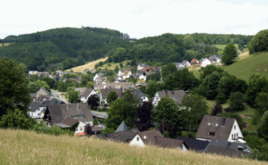Bonzel (Lennestadt)
|
Bonzel
City of Lennestadt
Coordinates: 51 ° 7 ′ 7 ″ N , 8 ° 1 ′ 26 ″ E
|
||
|---|---|---|
| Height : | 299 m | |
| Residents : | 405 (Jun 30, 2020) | |
| Postal code : | 57368 | |
| Area code : | 02721 | |
|
Location of Bonzel in Lennestadt |
||
|
View of the place
|
||
Bonzel is a district of Lennestadt in the Olpe district in North Rhine-Westphalia .
history
Documentary evidence of the existence of the place goes back to the 13th century. Examples are: 1279 Bonslede (in a tithing register ), 1393 Diderich von Bonssler (in loan books), 1465 Hof zu Bonslade, 1543 Boensell (in an estimate register ) and a. The actual development of the place is assumed earlier, around the middle of the 11th century. The derivation of the name can not be explained with certainty according to a recent study of the place names in the district of Olpe. Based on the word elements “-slede” for lowland or valley basin and “bon-” as a personal name Buni / Buno or the plant name “bean”, the place name can be interpreted as “valley basin des Buni / Buni” or as a place name for the location “in a valley depression with the occurrence of beans or legumes "
For almost 300 years, until around 1350, Bonzel must have been a small rural settlement with barely more than three farms . The von Bonslede ministerial family can be traced here since 1373 . The lords of Bonslede were in the service of the mighty Counts of the Mark , who at that time also owned the Bilstein rule, which extended over large parts of the Sauerland.
The residence of those von Bonslede was exactly in the middle of the path between two militarily and strategically important places of the Bilstein rule: the Lennefurt near Grevenbrück in the north and the Bilstein castle complex in the south. - Waldemar Bonsels , the author of “ Maya the Bee ”, traces his family tree back to this family von Bonslede.
The estates of the Lords of Bonslede were split up through several inheritance divisions. One of the old farms that emerged from these divisions is the Blefgen farm ("dat Bleffgen" = "dat Bliefken" = what is left).
Clues about the size of the place arise for the first time from an appraisal register (used to collect taxes) from the year 1543. This lists 10 persons liable for the treasury for “Boensell”. If one equates the number of those liable for the treasure with the number of existing families or houses and calculates 6 residents per house, then around 60 people should have lived in Bonzel at this time. At the end of June 2020 the population was 405, with the proportion of young residents up to 18 years of age at 21.5% being above the average (urban area: 20.0%).
chapel
Today's chapel , which is supported by the local “Kapellenverein”, dates from 1924 and was designed and built by the building contractor Anton Sunder-Plassmann from Förde (today Grevenbrück ). It stands on the site of the ancient chapel, which verifiably was inaugurated in 1647 - shortly before the end of the Thirty Years' War . Valuable portraits and the ancient oak chapel door have been preserved.
Traffic development
For centuries, the Veischedetal was - in contrast to today - almost insignificant for through traffic. In the Middle Ages, the nearest important long-distance road, the “Roman Path”, ran only a quarter of an hour away over the heights between Petmecke and Niederhelden on the other side of the Veischedetal. The " Heidenstrasse " is also not far away. The old village road, running on the right bank of the Veischede , was only expanded in 1820 as the Prussian provincial road Minden - Koblenz like a lake and provided with Prussian milestones. Today it is called " Bundesstrasse 55 ". From 1904 to 1916 Bonzel had a connection to the Ruhr-Sieg line with the Veischedetalbahn , a trolleybus service to Grevenbrück station .
In 1970 a bypass road was built for the lower village . The Veischedebett was moved further west to the mountainside. The mill ditch to supply the Grevenbrücker grain mill has also been removed. The place took on a completely different face.
In recent years Bonzel has expanded considerably by opening up new building areas.
literature
- Günther Becker: Bonzel - history of the village Bonzel (city Lennestadt) and the family of Bonslede . Lennestadt 1979.
- Franz-Josef Schütte: The history of our neighboring village Bonzel . In: Annual issue of the Heimat- und Verkehrsverein Grevenbrück eV issue No. 24, edition 2005. pp. 33–39.
Web links
Individual evidence
- ↑ cf. in detail Flöer, Michael, The place names of the district of Olpe, Westphalian Place Name Book (WOB), Bielefeld: Verlag für Regionalgeschichte 2014, pp. 52–54
- ↑ The population of the Electoral Cologne Sauerland in 1543 (Treasury register 1543), p. 44 ( Memento of October 3, 2011 in the Internet Archive )
- ^ Information from the city of Lennestadt






